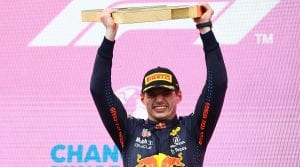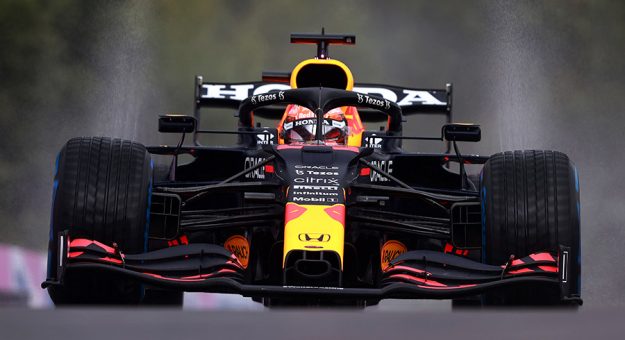The seeds of Red Bull’s return to the front of the Formula 1 pack were sown last year. Red Bull, of course, dominated for four years (2010-’13), winning four consecutive constructors’ world championships and four consecutive drivers’ world championships with Sebastian Vettel.
But since F-1 switched to the turbo hybrid power units in 2014, it has been all about Mercedes and Lewis Hamilton. The start of this season saw Hamilton win three of the first four races and Max Verstappen finished second in those three and won the fourth race in his Red Bull Honda.
Verstappen then won four of the next five races with his teammate, Sergio Perez, also picking up the victory. The last time Red Bull won five consecutive races was in 2013.
Prior to this year, Verstappen had never won back-to-back F-1 races. Now he had won three on the trot. Prior to this year, Verstappen had never led the F-1 standings. He now had a 32-point lead over Mercedes driver Hamilton.
“I’m enjoying it, but I’m also focused on the rest of the season,” Verstappen said at the time. “It is still so long and there are still a lot of points you need to score. We need to make sure that every single weekend we are back up there and we basically use the whole potential of the car.”
Verstappen almost certainly would have won the British Grand Prix had Hamilton not sent him into the barrier early in the race. Verstappen probably would have won in Hungary as well if Hamilton’s teammate, Valtteri Bottas, had not crashed into him just after the start of the race.
During the span of those two races, Verstappen went from having a 32-point lead in the championship to trailing Hamilton by eight points.
“The first half of the season went better than we expected,” Red Bull’s racing adviser Dr. Helmut Marko told Speedweek. “We are on a par with Mercedes in terms of both chassis and engine. Max is on a driving high, in his best year so far. Then came the big disaster, through no fault of our own.”
In recent years, Red Bull has had an unfortunate trend of starting the season with a car that was not fully competitive, developing that car during the season and having a fast car toward the end of the season. By then, of course, it was too late to make a title assault.

But it was different this time. Because of the pandemic, the radical technical rules package for 2021 was delayed until 2022 and the teams had to use their 2020 cars again this year with only a limited number of upgrades permitted. Verstappen won the final race of 2020 and he and Red Bull carried that momentum into this season.
A seemingly minor tweak to the technical regulations affected Mercedes more than Red Bull. In qualifying last year, the Mercedes W11 was on average half a second faster than the Red Bull RB16. This year’s Red Bull RB16B is faster than the Mercedes W12.
To slow the cars this year, the FIA stipulated that a triangular area of the rear floor edge, just ahead of the rear tires, would be removed. The reason for slowing the cars was to reduce some of the strain on the tires.
Mercedes has long followed a “low rake” design philosophy, with the front and rear of the car low to the ground. Red Bull has pursued a “high rake” philosophy, with the nose low to the ground and the tail of the car perched in the air. Removing that tiny piece of floor meant the new Mercedes was hampered by rear-end instability whereas the Red Bull was planted to the ground.
The Aston Martin, formerly Racing Point, is the other low rake car in the field and that team is struggling even more than Mercedes.
By July, the Mercedes was on average 1.702 percent slower than last year’s car, while the Red Bull was 1.069 percent slower than its 2020 car.
“What has definitely been true is that ever since the rule changes that were introduced aerodynamically for looking after the tires, we have found it hellishly hard to find the sort of performance gain rate that we did prior to those rules, so that has made our lives trickier than we wished it to be,” said James Allison, the chief technical officer at Mercedes.
Hamilton’s wins proved the team managed to claw back some of the car’s balance.
Furthermore, the RB16 was an all-new design whereas the W11 was at the end of a design cycle.
This is the first year for F-1’s new budget cap. While it’s pegged at $145 million, the big teams can no longer throw money at parallel development projects. The cap drops $5 million a year to $135 million by 2023.
Also by July, Mercedes had pretty much stopped developing its 2021 car to concentrate its resources on 2022 and beyond. Red Bull, meanwhile, keeps bringing upgrades for its current car.
“Look, you have to go week by week, race by race,” Red Bull team boss Christian Horner said. “The team is doing a great job of balancing the challenges of this year and next. It is nothing new. We have had big regulation changes in the past. You just have to balance your resource and apply it to what needs it most.”
Marko added, “We don’t want to make the same mistake as BMW did in 2008. Robert Kubica had a realistic chance of winning the championship, but the business plan was to switch to next season early on.”
Verstappen acknowledged that his car improves from race to race.
“I don’t know what’s going on with other teams, but I know that of course, from our side, we do improve our car almost every race, which I think is very important because we have a good opportunity to have a good season. I’m confident with the people we have in the team that also the focus for next year is 100 percent. So far, I don’t see that compromise — but of course time will tell next year if it’s like that! I fully agree with the approach we have for this season.”
So it is (almost) full steam ahead for Red Bull and Verstappen as the team aims at its first world title since 2013.
